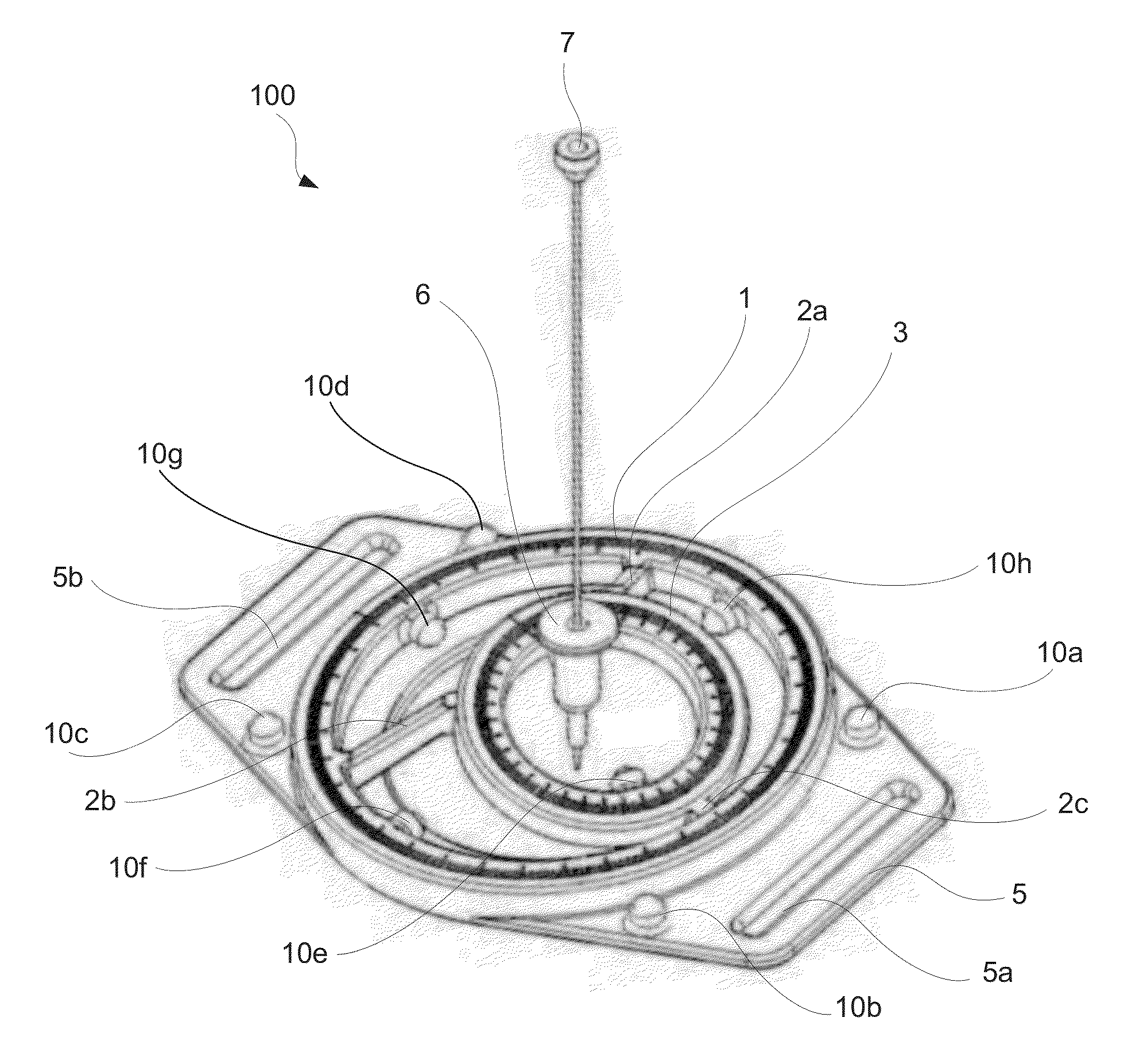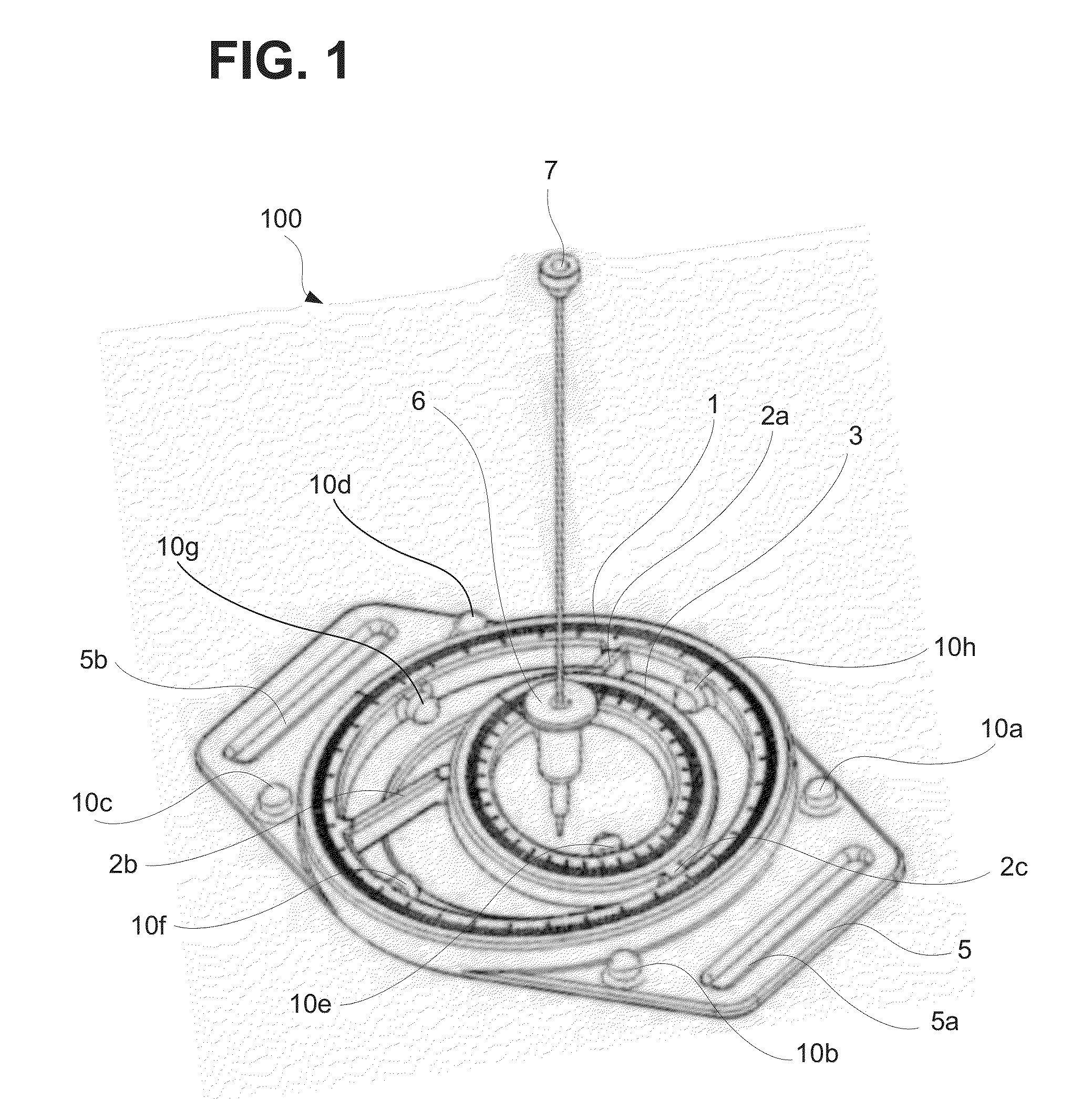Needle placement manipulator with two rotary guides
a technology of manipulators and needles, applied in the field of medical devices, can solve the problems of long trial and error routines, affecting the function of the patient, and affecting the patient,
- Summary
- Abstract
- Description
- Claims
- Application Information
AI Technical Summary
Benefits of technology
Problems solved by technology
Method used
Image
Examples
first embodiment
[0037]As illustrated in FIG. 1, a needle placement manipulator 100 includes two circular ring-shaped rotary guides (hereinafter referred simply to as “rotary guides”), which are arranged in a slanted orientation with respect to each other atop a base body 5. Specifically, a first rotary guide 1 and a second rotary guide 3 are arranged in a slanted orientation with respect to each other. The two rotary guides 1 and 3 are supported by a base body 5. The base body 5 is preferably a non-magnetic structure configured to be mounted on a patient's skin 8. As discussed in more detail below, the base body 5 and certain other elements can be manufactured of disposable and recyclable materials, such as plastics and / or composites thereof. The first rotary guide 1 is supported by the base body 5 and connects to a first rotation body 2. The second rotary guide 3 is supported by the first rotation body 2 and connects to a second rotation body 4. The second rotation body 4 is configured to support...
second embodiment
[0070]FIG. 6B illustrates a variation of the second embodiment where, in the first rotation drive unit 210, a light source fiber fs1 delivers light to the rotary scale 18 and a collecting fiber fd1 is used to detect light reflected from the rotary scale 18. Similarly, in the second rotation drive unit 220, a light source fiber fs2 delivers light to the rotary scale 28 and a collecting fiber fd2 is used to detect light reflected from the rotary scale 28. The use of optical fibers may be particularly desirable to avoid the use of electrical wiring for minimizing noise and interference in the MRI system, in particular to avoid interference with RF-pulse signals.
[0071]Advantageously, in the second embodiment, accurate positioning up to an order of microns can be implemented by the use of optical rotary position sensors and piezoelectric actuators. Accurate positioning is available by piezoelectric actuator and feedback signaling, which can be automated by controllers operated with progr...
third embodiment
[0078]FIG. 8B illustrates a perspective view of the manipulator 300 mounted onto RF-coil 32 in which a sectional cut along vertical plane H-H is performed. FIG. 9A illustrates a sectional view of the needle placement manipulator cut along a vertical plane H-H, according to the The first attachment 30 includes a flat setting portion on which the RF-coil 32 is set, and a circular projection portion 30a configured to engage with the second attachment 31. Similarly, the second attachment 31 includes a flat setting portion below which the RF-coil is set, and a circular projection portion 31a which engages with the projection portion 30a of the first attachment 30.
[0079]As illustrated in FIG. 9A, the single loop RF-coil 32 is placed with the circular projection 30a of attachment 30 going through the opening of the RF-coil 32. The second attachment 31 is fixed to the base body 5 and the circular projection section 31a is disposed at the bottom surface thereof. These two attachments 30 and...
PUM
 Login to View More
Login to View More Abstract
Description
Claims
Application Information
 Login to View More
Login to View More - R&D
- Intellectual Property
- Life Sciences
- Materials
- Tech Scout
- Unparalleled Data Quality
- Higher Quality Content
- 60% Fewer Hallucinations
Browse by: Latest US Patents, China's latest patents, Technical Efficacy Thesaurus, Application Domain, Technology Topic, Popular Technical Reports.
© 2025 PatSnap. All rights reserved.Legal|Privacy policy|Modern Slavery Act Transparency Statement|Sitemap|About US| Contact US: help@patsnap.com



